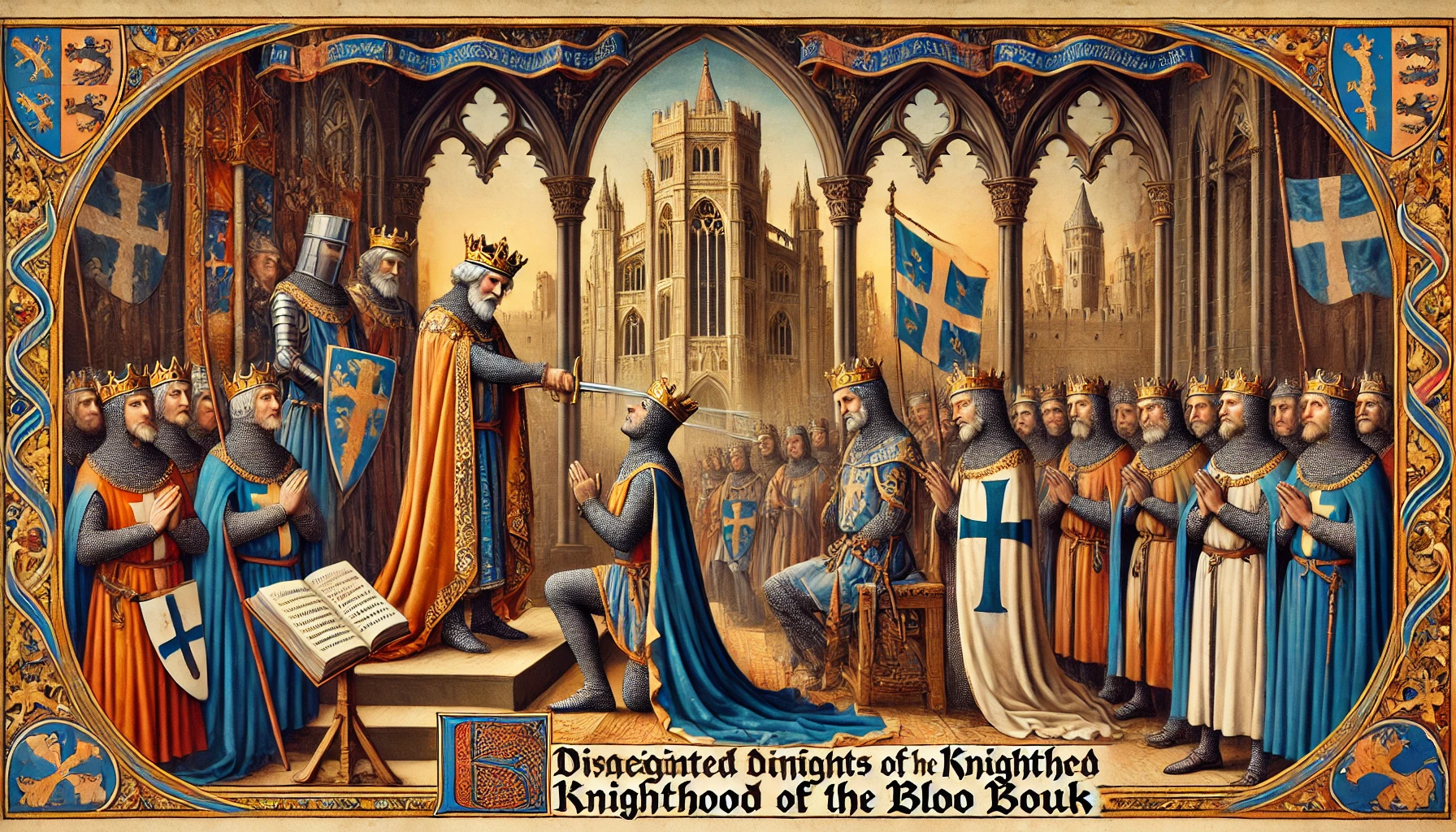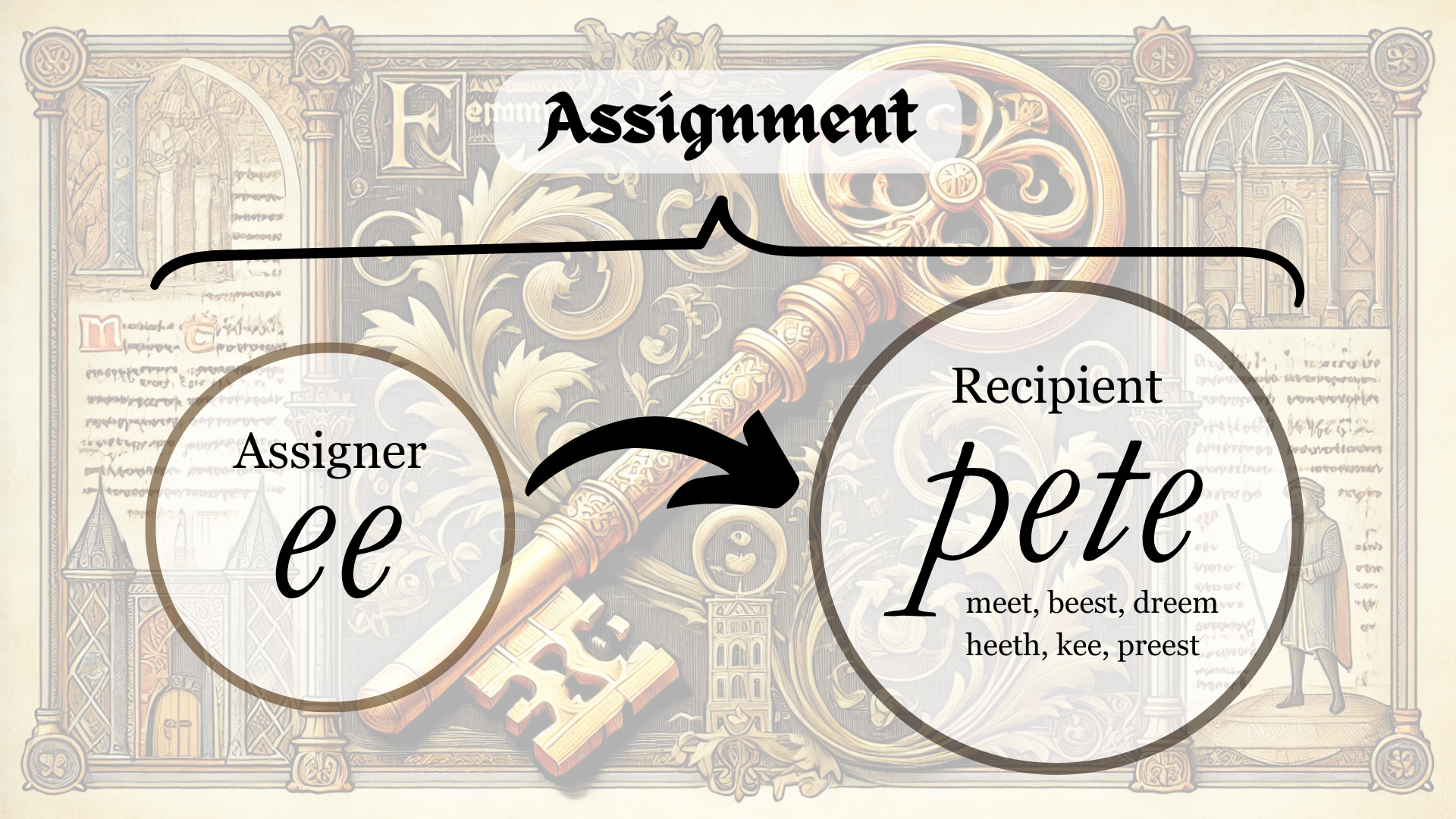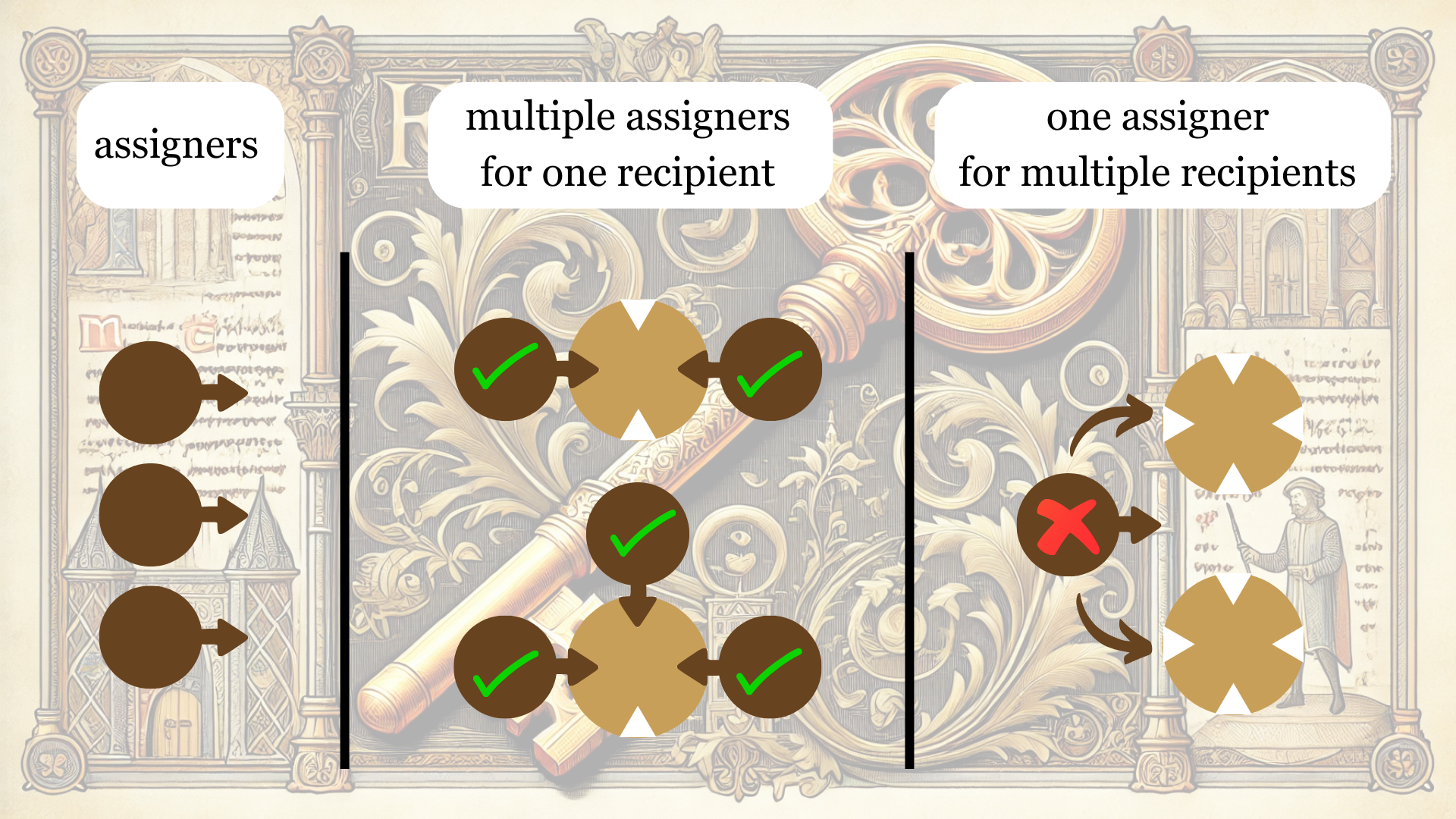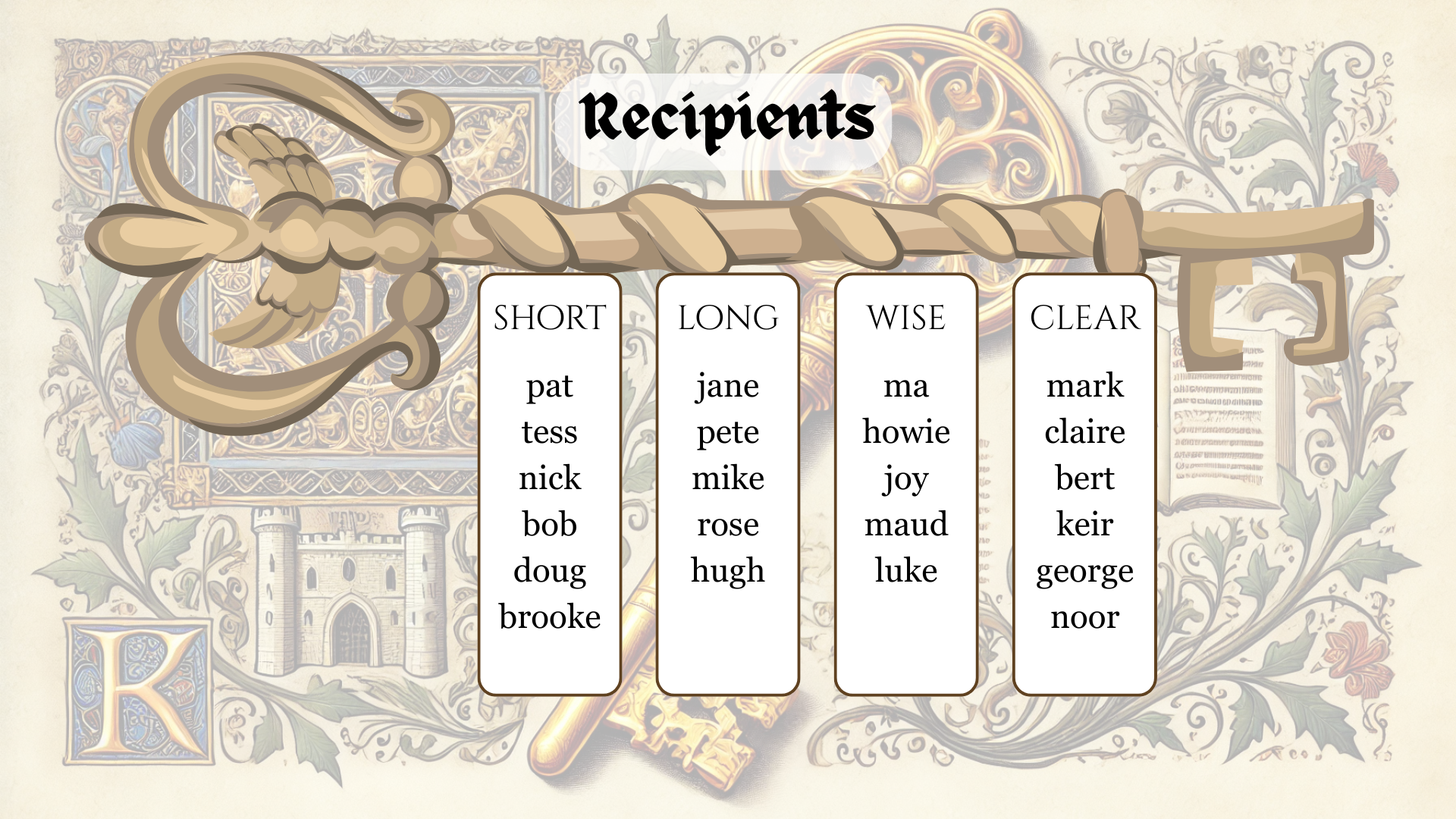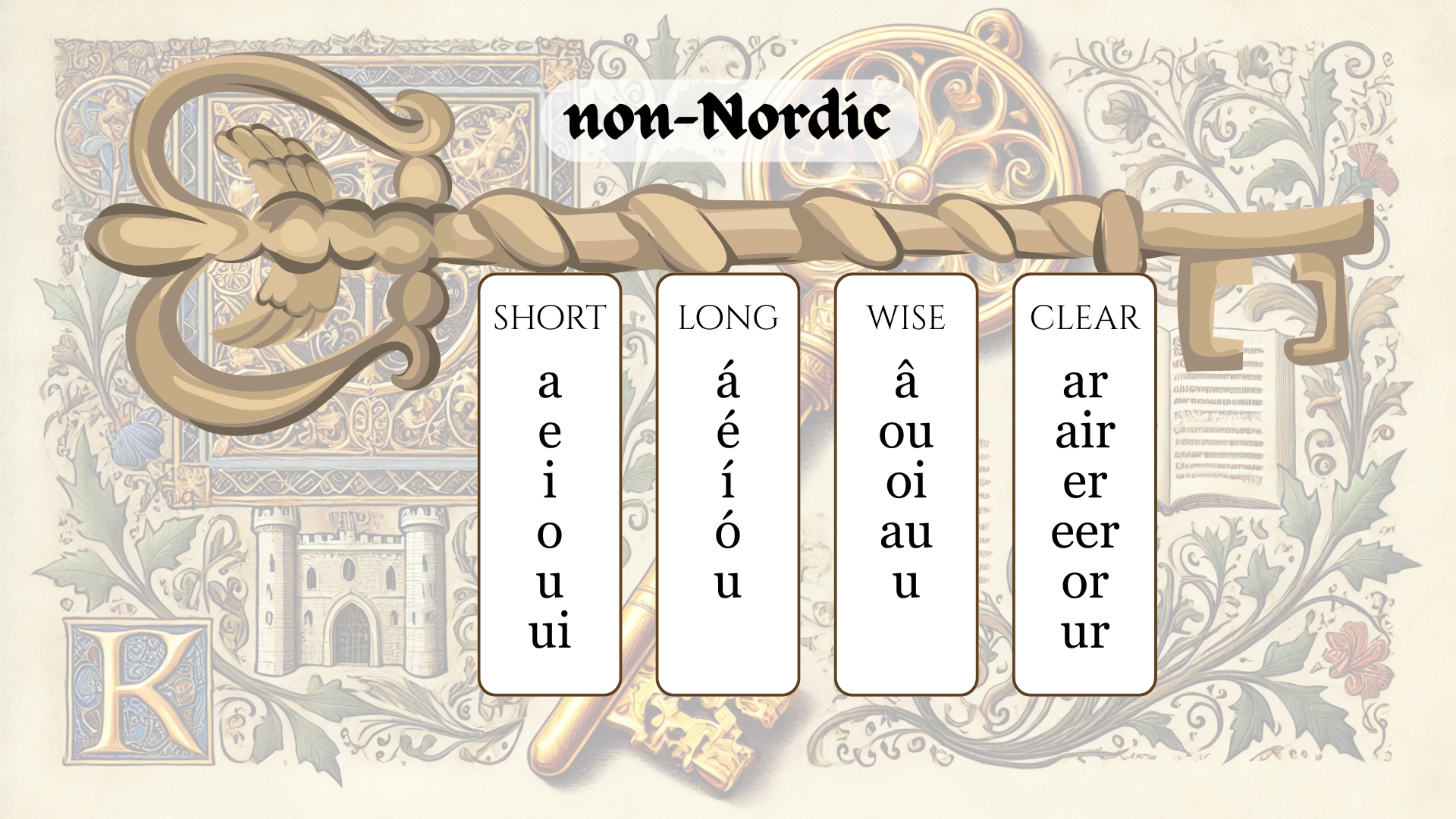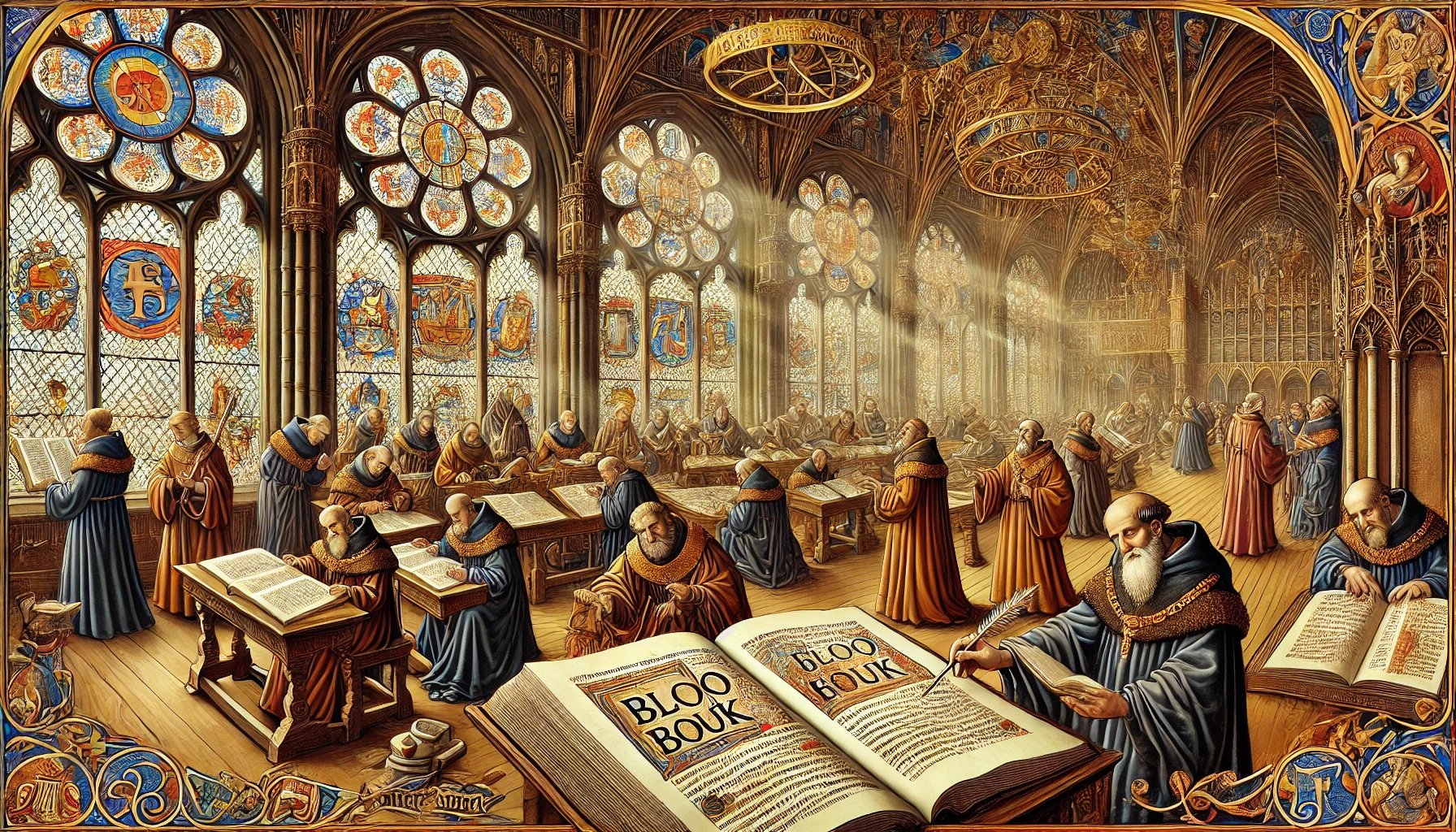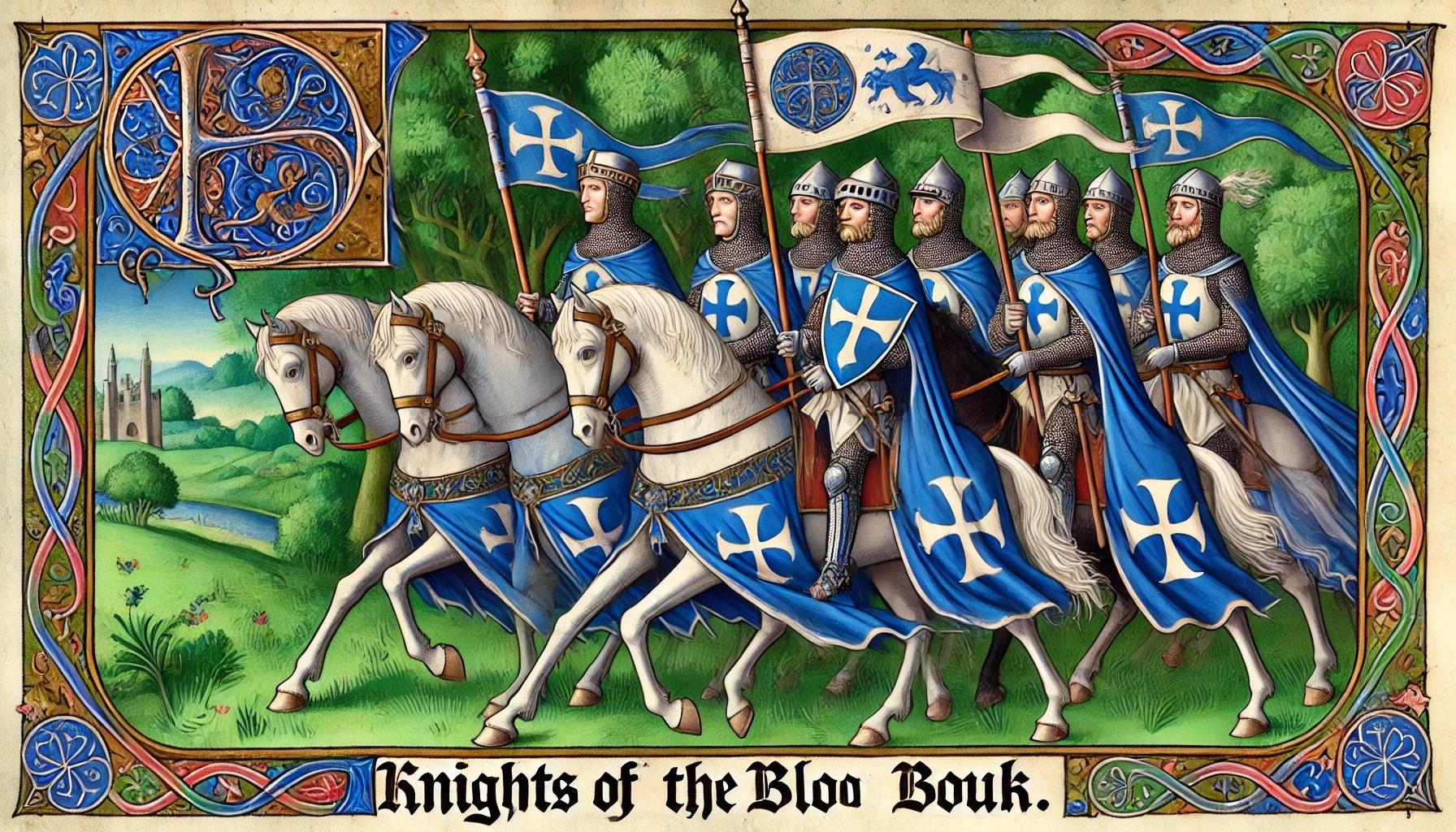1. In the Bloo Bouk, English vowels are divided into five didactic groups: short, long, wise, clear, reduced. Their rendition is ruled by two keys: Nordic, non-Nordic.
The bulk of the vowel standards on this page was codified by the great conclave of 1687.
2. A key is a set of assignments.
3. An assignment is the allocation of an assigner to a recipient.
4. An assigner is one of the 29 vowel letters and combinations handed down by tradition, available for assignments:
Assigners
| a, æ, ai, au |
| e, ea, ee, ei, eo, eu |
| i, ie |
| o, oa, œ, oi, oo, ou |
| u, ue, ui |
| y, ay, ey, oy, uy |
| aw, ew, ow |
The vowels æ and œ may be written ae and oe. For the use of graphic accentuation for stress and length, cf. Accentuation.

5. A recipient is a traditional sound of speech to which an assigner is assigned. Recipients are called after a name or sound that carries the vowel:
Recipients
| pat, tess, nick, bob, doug, brooke |
| jane, pete, mike, rose, hugh |
| ma, howie, joy, maud, luke |
| mark, claire, bert, keir, george, noor |
| jacob, little nick, little brooke |
6. The recipients correspond to the following phonemes:
| /a ɛ ɪ ɔ ɐ ʊ/ |
| /eɪ iː ɑɪ əʊ jʉː/ |
| /ɑː aʊ ɔɪ ɔː ʉː/ |
| /ɑː ɛə ɜː ɪə ɔː ʊə/ |
| /ə ɪ ʊ/ |
The vowel phoneme associated with a recipient may be a monophthong (pat: /a/) or a diphthong (joy: /ɔɪ/).
Recipients are not phonemes. A phoneme is a scientific description. A recipient is a cultural perception. The same recipient may be pronounced with different phonemes, like bob in the UK and the US. It can also be a phonetically arbitrary compound: hugh is nothing but luke preceded by a semivowel. But the distinction is culturally relevant: hugh as a “long” vowel names the letter u, while luke does not and is therefore a “wise” vowel.
English pronunciation is not uniform. The above phonemes represent a subjective perception of British received pronunciation in an educated environment in Winchester. While the list may be a didactic starting point for phonetic literacy, it does not lay any normative claim on English Pronunciation.


7. Orthography may be:
- monoglotic when one spelling system fits all words, e.g. French.
- polyglotic when several systems coexist, e.g. Bloo Bouk English.
8. The Bloo Bouk divides English vowels into two spelling systems, called keys. Each key has its own method of assignments. The keys control words from the following families:
Keys
| Nordic | non-Nordic |
|---|---|
| Old English | Latin, Old French, Anglo-Norman |
| Middle English | Middle French, early Modern French |
| Old Norse | early Romance languages |
| German & Dutch | Ancient Greek, Latin from Greek |
| Scandinavian languages | modern Greek, Greek disputed |
| Celtic languages | unknown origin, neologisms |
The assignments of one key do not apply to another:
- one key may assign assigner x to maud,
- another key might assign assigner y to it.


9. A key assigns an assigner to each recipient. A recipient can receive more than one assigner, but an assigner can only be assigned to one recipient. e.g:
- both ai and ei could be assigned to jane,
- but once they are assigned to jane, no other recipient can have them.
An assignment is therefore:
- unique when only one assigner is assigned: a to pat in the Nordic key.
- multiple when several are assigned: u and ue to hugh in the non-Nordic key.
Multiple assigners are assigned for different contexts, e.g. in non-Nordic hugh/luke:
- u for word beginning and middle: unity, polucion.
- ue for closed unstressed final syllable: values, pròdues, cuet.


10. Alien words are words from the above languages loaned into English after ca. 1700. Alien words keep their alien spelling if:
- the word becomes unrecognisable, e.g.:
French rendezvous, étude, façade > *randævu, *ætued, *fassâd; - the word has non-vernacular phonemes, e.g.
French gendarme, joie de vivre, malheur, huile.
The following Modern French phonemes cannot be accommodated: /ʒ ɥ wɑ y œ ø ɛ̃ œ̃ ɑ̃ ɔ̃/.
11. Facultatively, French aliens follow the non-Nordic key if:
- the word remains recognisable, e.g.:
French groupe > group > gruep; - current pronunciation has made the spelling unrecognisable, e.g.:
French reveille > revàly.
A French alien is a word of French origin loaned into English after ca. 1700. The words loaned between the Norman period and the early modern age are French vernaculars.
The latest revision of Bloo Bouk spelling dates back to 1687. Its keys focus on the main lexical sources of English at the time. While English has become an international language since then, the foreign inputs from Anglo-Norman, Latin and Greek can still be described as the most substantial.
The division of orthography into keys must not be misconstrued as a judgement on cultural value. While the linguistic origin of the different keys is worth celebrating, it must not lead to any from of discrimination, which the Knighthood of the Bloo Bouk has always forbidden.

12. Spelling is the most common writing of a word. Orthography is the art of shaping word-writing for aesthetic excellence.
A lexicographer describes a word in its most common writing. An orthographer writes a word in its best aesthetic shape.
Linguistics is the science of describing language. Orthography is not a branch of linguistics as a science, but a separate art. A linguist is not allowed to judge language aesthetically. Orthography is the aesthetic judgement of the shape of written words. An orthographer’s work is enriched by linguistic training, but linguistics alone does not make an orthographer.
Aesthetic judgement, however reasonable, is biased. It is the linguist’s duty of science to point out the orthographer’s bias. And it is the orthographer’s art to own it.
An orthographer is not concerned with spelling reform, social reform or language control. Orthography is an aesthetic pursuit, rewarded primarily, like every other art, by the inherent pleasure of the exertion.

13. An orthographic requirement is a justified expectation regarding the result of an assignment.
The Bloo Bouk upholds the following requirements:
- phonological requirement: the assignment must indicate pronunciation.
- etymological requirement: the assignment must reflect word origin.
- customary requirement: the assignment must look familiar.
- aesthetic requirement: the assigment must please the eye.
The Bloo Bouk blends the requirements in a balanced manner. Exaggerated focus on only one requirement leads to the following degenerations:
- phoneticism turns spelling into phonetic transcription, e.g.
Ðë sìti jùj ëbzêrvz ðë këndìshënz ëv ðe jùjmënt, instead of
The city jugg obzérvs the condicions ov the juggment. - primitivism turns spelling into an archeological museum, e.g.
Yck habbe allewayghaes y-loubbed yeow, instead of
Y hav oalwæs luvd u. - usualism turns spelling into a traditionalist cult, e.g.
People compete to meet the priest on the heath, instead of
Pépel compét to meet the preest on the heeth. - mannerism turns spelling into cosmetic aestheticism, e.g.
I have much love to give the dove I live for, instead of
Y hav much luv to giv the duv Y liv for.
14. The Bloo Bouk implements a balance of requirements in the following way:
- phonological requirement: within a key, every assigment is allocated primarily to indicate pronunciation.
- etymological requirement: English words are divided into etymological families, each with a different key of assignments.
- customary requirement: regardless of the key, every assignment shows a degree of historical precedence.
- aesthetic requirement: every assignment is regarded as an elegant solution by a reasonable number of learned speakers.
Thus, every Bloo Bouk assignment follows the steps below:
- word isolation: assesses etymology and assigns the word to a key.
- recipient isolation: isolates the desired recipient.
- assigner isolation: identifies the assigners available for the recipient.
- customary assessment: assesses the assigners recurrent in the authoritative sources.
- aesthetic judgement: selects the most non-intrusive and non-innovative candidates.
- aesthetic probation: tests the assignment on other words in the same key.
- final assignation: standardises the assignment of an assigner to a recipient.

15. Customary justification clarifies how an assignment aligns with tradition. No language exists in a cultural vacuum. The price of accurate spelling cannot be arbitrary innovation.
Although every art has infinite tools of expression, the most refined works seek to make the best out of limited resources. The orthographer’s tools are the assigners. Originality is not an unlearned break with tradition but a critical dialogue, of which the orthographic outcome looks refreshed without feeling alien.
16. An assignment is justified by custom when the assigner occurs in the same word, or in a similar context, in authoritative sources.
17. Historical sources have different degrees of authority. A degree of authority informs the ability of a source to be a reference of good spelling.
18. The Bloo Bouk bases its assignments on a hierarchy of four degrees of authority:
- First degree: the assigner is recurrent in a similar lexical context in Chaucer or the Matter of England.
- Second degree: the assigner is recurrent in Modern English, whether or not directly applied to the target recipient.
- Third degree: the assigner occurs only occasionally in Old, Middle or Modern English, or is recurrent but in a different context.
- Fourth degree: the assigner is loaned from a related language due to insufficient vernacular solutions.
Thus ou is a first degree assignment to brooke in fout [foot]: the assigner occurs in the same word in King Horn, even though the recipient may have been another. The familiarity we seek speaks not to the ear, but to the eye.
Chaucer and the Matter of England are undoubtedly more authoritative sources than Modern English. Middle English spellings, even when not uniform, are more consistent, predictable, and therefore reliable. Modern English assignments are deeply manneristic. They were coined by printers, lexicographers and chancery officers with limited knowledge of phonetics and etymology, who dismissed assigners handed down by tradition even when still functional, consistent and elegant.

The following tables show English vowels in the Bloo Bouk code (click the arrow). Vowels without key specification are the same in all keys, e.g. pat, tess, nick.
For the spelling of affixes, cf. Morphology. Some phonological inconsistencies cannot be fully resolved orthographically, e.g. in the distinction between hugh and luke.
To hear the sound of the English vowels, cf. Pronunciation.




A. Short Vowels
Lax monophthongspat
| am | carrot | black | clad |
| that | attach | pattern | plaid |
| cat | catch | tract | meringue |
| apple | attack | badge | reveille |
| m | crot | blk | cld |
| tht | atch | ptern | pld |
| ct | cch | trct | merng |
| pel | atk | bgg | revly |
First degree
for graphic accentuation, cf Accentuation.
tess
| get | bread | said | pleasant |
| very | head | says | leisure |
| many | dreamt | berry | heifer |
| any | cleanse | bury | leopard |
| gt | brd | sd | plsant |
| vry | hd | ss | lsur |
| mny | drmt | bry | hfer |
| ny | clnz | bry | lpard |
First degree:
cf. Havelok the Dane: deth, bred, frend, brest, dred.
cf. King Horn: eny.
nick
| win | city | minute | biscuit |
| give | finish | vivid | bicycle |
| kiss | spirit | system | busy |
| rich | lyric | sieve | women |
| wn | cty | mnut | bskit |
| gv | fnish | vvid | bíckel |
| kss | sprit | sstem | bsy |
| rch | lrik | sv | wmen |
First degree:
cf. King Horn: wimman.
cf. Canterbury Tales, 1491-1492:
The bisy larke, messager of day,
Saluëth in hir song the morwe gray.
bob
| not | doctor | shone | laurel |
| font | what | because | cough |
| donkey | wash | sausage | knowledge |
| bomb | swan | bureaucracy | yacht |
| nt | dctor | shn | lrel |
| fnt | wt | bicz | cf |
| dnky | wsh | ssagg | nlegg |
| bm | swn | burkrassy | yt |
First degree
doug
| but | done | flood | courage |
| club | front | blood | trouble |
| gull | worry | couple | young |
| udder | other | country | hiccough |
| bt | dn | fld | cragg |
| clb | frnt | bld | trbel |
| gl | wry | cpel | yng |
| der | dder | cntry | hicp |
First degree:
cf. Havelok the Dane: yung, sum, cum, dun.
cf. King Horn: luve, luved, luvede.
brooke | Nordic
| could | look | pull | wolf |
| should | book | put | bosom |
| would | took | full | woman |
| wood | bull | foot | good |
| cd | lk | pl | wlf |
| shd | bk | pt | bsom |
| wd | tk | fl | wman |
| wd | bl | ft | gd |
First degree:
cf. Havelok the Dane: coude.
cf. King Horn, 137-138:
Of schup hi gunne funde,
And setten fout to grunde.
brooke | non-Nordic
| cushion | bullet | push | cook |
| cshon | blet | psh | ck |
Third degree:
ou is reserved for howie (non-Nordic key), and u for doug.
ui is not used as above in Modern English, but is the closest Anglo-French digraph available.

A poetry contest in the gardens of Sherborn Abbey in the early 13th century. Out of royal favour since the Norman conquest, the monks, scholars and knights sought to cultivate the old language by encouraging literary production and oral tradition among the people. Aldhelm’s language no longer existed, and a gradual adjustment of the Bloo Bouk to the new tongue was taking place.

B. Long Vowels
Tense monophthongs and diphthongs culturally perceived as long, alphabetic names of the vowels a, e, i, o, u19. In the Bloo Bouk, there are two rules of vowel elongation:
- rule of the added e: ae, ee, ie, oe, ue: gaelic, flee, tie, toe, clue
- rule of the rising accent: á, é, í, ó, ú: nácion, réson, líbel, lócal, cúbik
In general, the first rule applies to the Nordic key, the second to the non-Nordic one.
20. In the Nordic key, the customary requirement calls for a balanced application. If another assigner is a more common elongator in Middle English, preference is given to it:
- ee is upheld in ME: meet, preest, heeth
- y replaces ie: tie, riet, tiem > ty, ryt, tym
- oo replaces ue in luke: shue, flue > shoo, floo
- ew replaces ue in hugh: nue, due > new, dew
21. The aesthetic requirement also calls for a balance. If Middle and Modern English have no consistent precedent of an elongating assigner, preference is given to the assigner least intrusive to the eye. The aesthetic justifications for ae and oe (or æ and œ) are:
- ae is already used as a split digraph: lake, make, take > laek, maek, taek
- ae has popular appeal as an assigner for jane: Sundae, reggae
- ae is a graphic splitting of Old English ash: mæt, dæg; bæcere > baeker, baek, baeking
- oe is used in the same assignment, albeit rarely: doe, foe, goes, toe, woe
- oe is already used as a split digraph: broke, spoke, rode > broek, spoek, roed
- oe can form a discreet ligature: brœk, spœk, rœd, cœt, bœt, cœld, gœst
22. The phonological requirement is equally fulfilled. It is not the mere shape of a letter that indicates pronunciation, but its consistent allocation as a mnemonic pattern. Though ei could be assigned to jane due to its visual resemblance to /eɪ/, the assignment would have no customary justification in the Nordic key.

23. In the non-Nordic key, accentuation prevents the unnecessary rewriting of assigners shared with a continuum of Romance languages. Similarly, the rule of the added e does not fundamentally reshape an assigner.
24. The non-Nordic key applies the rules of elongation as follows:
- rising accent: stressed position in non-monsyllables: nácion, narrát, légal, concéd, líbel, lócal
- added e: unstressed position and monosyllables: fassinæt, lœcácion, próteen, ceed, Rœm, fæth
Unstressed mike remains y: ydìa, dyàlissis, mygrácion.
For the elongation of non-Nordic u, cf. Differential Accentuation.
25. Non-Nordic a is elongated through multiple assigners:
- rising accent: stressed position in non-monsyllables: nácion, narrát
- added e: unstressed position and monosyllables: fassinæt, fæth, dæm, sænt
- facultative ai/ei: Anglo-Norman monosyllables: faith/feith, saint/seint (but fáthful, sántly)
- French ay: open final unstressed or monosyllable: pay, cafay, valay, puray, Calay
- French áy: open final stressed: aráy, obáy, blasáy, repáy, conváy, passáy
For French ai, ei and ay inflections, cf. Morphology.
jane
| make | eight | wait | range |
| day | ate | weight | straight |
| rain | thegn | gaelic | halfpenny |
| reign | great | nation | chaos |
| mk | t | wt | rngg |
| d | t | wt | strt |
| rn | thn | glic | hpny |
| rn | grt | ncion | kos |
Second degree:
jane followed by e or i is written aye ayi: pay, pays, payd > paying, payer, payé.
In French monossyllables, closed jane may also be written ei or ai:
seint, feith, cleim | clæming > cleim, cleims, cleimd
saint, faith, claim | clæming > claim, claims, claimd
cf. Canterbury Tales: seint, feith, complein | baillif, traitour, fail(e)
pete
| meet | evil | sardine | machine |
| eat | clean | serene | caffeine |
| meat | people | receive | priest |
| field | seat | cede | least |
| mt | vil | sardn | mashn |
| t | cln | sern | cafn |
| mt | ppel | recv | prst |
| fld | st | cd | lst |
First degree:
cf. Canterbury Tales: dreem, preest, heeth, ete > eet
pépel, mashéen: non-Nordic, non-monosyllable, stressed pete is rendered as é.
mike
| time | write | tie | type |
| fire | right | high | sign |
| night | indict | guide | dry |
| height | rite | dissect | icy |
| tm | rt | t | tp |
| fer | rt | h | sn |
| nt | indt | gud | dr |
| ht | rt | dssèct | ssy |
First degree:
cf. Canterbury Tales: tym, hy, lyk.
indít: non-Nordic, non-monosyllable, stressed mike is rendered as í.
Suffixal -y and -ly are not mike: ver-y, men-y, bis-y, yss-y, env-y, hy-ly, nyt-ly, lyk-ly.
In non-Nordic words, open mike is written ey:
by, dy, hy, ly, my, ty, wy (or hwy) | but: aley, deféy, aréy [awry]
tr-ey, cr-ey, pl-ey > retr-éy, decr-éy, supl-éy | but Nordic: by, dry, dy, fry
I > Y | ay, aye > y | eye, eyes/eyen > y, ys/yn | ice, iced, icing, icy > yss, yst, yssing, yssy
rose
| boat | bowl | cold | oat |
| bone | toe | flow | dote |
| brooch | though | owe | don’t |
| soul | coal | know | won’t |
| bt | bl | cld | t |
| bn | t | fl | dt |
| brch | th | dnt | |
| sl | cl | n | wnt |
Second degree:
cf. also Canterbury Tales: cote > cœt.
rose followed by e or i is written owe owi: flœ, flœs, flœd > flowing | lœ > lower, lowest.
non-Nordic rose in final position is written o: tomâto, macho, cargo, tobàco.
hugh | Nordic
| dew | few | mew | new |
| you | youth | ewe | yew |
| d | f | m | n |
| th |
First degree:
cf. Canterbury Tales: new, mew.
You comes from Old English eow, to which ew bears more resemblance.
luke-hugh | non-Nordic
(1) closed monosyllable, (2) unstressed closed final
| duke | produce | nude | tube |
| cute | juice | rude | tune |
| use | group | suit | mute |
| to use | move | revenues | values |
(1) open monosyllable, (2) initial and middle, (3) stressed closed final, (4) unstressed open final, (5) stressed open final
| view1 | duty2 | suitable2 | virtue4 |
| beauty2 | polution2 | moving2 | menu4 |
| union2 | nuance2 | assume3 | undue5 |
| using2 | nuisance2 | reduce3 | eschew5 |
(1) closed monosyllable, (2) unstressed closed final
| dk | pròds | nd | tb |
| ct | js | rd | tn |
| s | grp | st | mt |
| to z | mv | revens | vals |
Second degree:
luke and hugh are spelt the same way: rued [luke], muet [hugh].
luke occurs after j, l, r: jues, fruet, rued, fluet.
hugh occurs everywhere else: muet, nued, duek, cuet.
When luke occurs unexpectedly, it may be written ü[e]: müev, süet, sütabel.
When ue is a hiatus, it may be written uë: fluënt.
| v1 | dty2 | stabel2 [ü] | vert4 |
| bty2 | polcion2 | mving2 [ü] | men4 |
| nion2 | nans2 | assm3 | und5 |
| sing2 | nssans2 | reds3 | esch5 |
First degree:
In (2), hugh/luke is only accentuated if followed by two consonants: nússans
For more information on the accentuation of u, cf. Differential Accentuation.
In (3), hugh/luke is accentuated: redús, assúm, acút.
In (5), hugh/luke is accentuated: undû/undú, revû/revú, eschû/eschú.

A decorative banner used by the Knighthood of the Bloo Bouk, among several others, unknown date. Books and keys have been a feature of banners since the foundation of the knighthood by Edward the Confessor in 1054.

C. Wise Vowels
Tense monophthongs and diphthongs that do not name the vowels of the alphabet26. A wise letter is a letter that does not fit a given set of didactic classification. Wise vowels are phonologically long but not counted among the classic “long” vowels.
ma | Nordic
| ask | path | half | rather |
| after | paths | last | can’t |
| father | laugh | draft | glass |
| aunt | calf | bath | fasten |
| sk | pth | hf | rdder |
| fter | pdds | lst | cnt |
| fdder | lf | drft | gls |
| nt | cf | bth | fssen |
Third degree:
In writing that observes the bath-trap split, a unique assignment for ma is required.
Middle and Modern English do not provide authoritative references.
aw is recurrent in Modern English but not in the above use.
aa does not occur in Middle English and is not well established in Modern English.
ae and au are not available; à and ai are not Nordic.
aw is the closest Nordic assigner.
ma | non-Nordic
| plant | grant | class | past |
| chant | palm | pass | chanting |
| dance | calm | master | gala |
| advantage | enchant | tomato | disenchant |
| plnt | grnt | clss | pst |
| chnt | pm | pss | chnting |
| dns | cm | mster | gla |
| advntagg | enchnt | tomto | dissenchnt |
Fourth degree:
à and â are recurrent in Modern French, which shares most of the words in this group with Modern English.
au, which occurs in Middle English renditions such as plaunt and chaunt, is reserved for the more recurrent maud.
à : monosyllables and disyllables with stress in the penultimate syllable (i.e. paroxytones)
â : all other cases
cf. Differential Accentuation.
howie | Nordic
| out | drown | bow | foul |
| down | proud | house | row |
| now | thou | bough | fowl |
| how | sound | loud | sow |
| t | drn | b | fl |
| dn | prd | hs | r |
| n | th | b | fl |
| h | snd | ld | s |
Fourth degree:
ou is not available, as it is required for brooke (cf. Chaucer: coude, hence coud, woud, shoud).
au is the standard assignment in German, which shares the origin of most words in this group, cf.:
haus > Haus | sau > Sau | faul > faul | laud > laut | aut > aus
au is a remarkable assignment, as it provides the only direct phonological synchronisation.
howie followed by e or i is written awe awi: sawer, bawing.
howie | French only
| count | round | prow | fountain |
| doubt | sound | rout | crown |
| amount | pound | bounty | abound |
| allow | vow | county | found |
| cnt | rnd | pr | fntan |
| dt | snd | rt | crn |
| amnt | pnd | bnty | abnd |
| al | v | cnty | fnd |
First degree:
howie followed by e or i is written owe owi: power, vowing.
joy
| boy | anoint | choice | toil |
| toy | moist | toilet | boil |
| soil | coin | employ | envoy |
| foil | noise | android | poison |
| b | annt | chs | tl |
| t | mst | tlet | bl |
| sl | cn | empl | env |
| fl | nz | andrd | pson |
First degree:
joy is written oy in open final position: soy, envoy, emplóy.
maud | Nordic
| broad | talk | flaw | awe |
| bought | sought | raw | hawk |
| taught | fought | law | water |
| ought | naught | saw | daughter |
| brd | tk | fl | |
| bt | st | r | hk |
| tt | ft | l | wter |
| t | nt | s | dter |
Second degree:
oo is assigned to luke (cf. Chaucer: moon) and oe to rose (rule of the added e).
au is assigned to howie.
oa is assigned to maud in Modern English, albeit rarely: broad.
maud | non-Nordic
| cause | daunt | haunt | trauma |
| sauce | pawn | clause | author |
| salt | caught | fawn | pauper |
| altar | fraud | nausea | raucous |
| cz | dnt | hnt | trma |
| ss | pn | clz | thor |
| slt | ct | fn | pper |
| ltar | frd | nsea | rcos |
First degree
The Nordic key assigns au to howie: aut, haus, faul.
The non-Nordic key assigns au to maud: author, haunt, fault.
The Nordic key assigns ou to brooke: woud, foul, pout.
The non-Nordic key assigns ou to howie: rout, fount, pound.
luke | Nordic
| boot | lose | womb | soot |
| moon | shoe | through | cool |
| soon | blue | two | sleuth |
| food | true | goose | flew |
| bt | lz | wm | st |
| mn | sh | thr | cl |
| sn | bl | t | slth |
| fd | tr | gs | fl |
First degree:
cf. Canterbury Tales, 455-456:
Hir hosen weren of fyn scarlet reed,
Ful streite y-teyd, and shoos ful moiste and newe.

Monks and scholars at Malmesbury Abbey work on the Bloo Book at the time of King Alfred of Wessex (later illustration). Apart from producing biblical manuscripts in Old English, much of the work involved transcribing classical literature into Old English as well as copying celebrated Old English poetry, all under the Bloo Bouk keys.

D. Clear Vowels
R-controlled monophthongs and diphthongs27. In non-rhotic speech, a clear vowel is a vowel that absorbs the reduced r-sound. The name clear carries keir as an example.
28. In the Bloo Bouk, rhotic absorption may require the fixed accent on non-Nordic claire and keir. This procedure is called rhotic fixation. It prevents the confusion of clear ar and er with a coincidental encounter of pat and tess with r:
- no fixed accent: monosyllable or last syllable: mair, fair, cleer, apeer, compair, reveer
- fixed accent: non-monosyllable (initial/middle): clëring, päring, sërios, përiod, värios
- no clear vowels: pat and tess with r: perilos, mary, teribel, cary, meriment, Paris, very
mark
| park | bark | sergeant | bazaar |
| garden | car | clerk | guard |
| art | catarrh | hearken | star |
| party | arsenal | heart | farther |
| pk | bk | sgent | baz |
| gden | c | clk | gd |
| t | kat | hken | st |
| pty | senal | ht | fdder |
First degree:
In non-rhotic speech, mark is the same as ma.
claire | Nordic
| pear | tear | hair | dare |
| wear | their | there | fare |
| care | where | daring | bear |
| mare | scarce | they’re | bare |
| p | t | h | d |
| w | th | th | f |
| k | w | ding | b |
| m | sks | th | b |
Second degree
claire | non-Nordic
Final syllable or monosyllable
| fair | prepare | prayer | despair |
| air | impair | affair | flair |
| repair | mayor | rare | compère |
| heir | compare | unfair | square |
Initial and middle syllable
| vary | Mary | gregarious | airy |
| area | hilarous | rarity | variance |
| various | parents | fairy | precarious |
| arial | aeroplane | nefarious | repairing |
Final syllable or monosyllable
| f | prep | pr | desp |
| imp | af | fl | |
| rep | m | r | comp |
| comp | unf | squ |
First degree
cf. Canterbury Tales: fair(e), pair(e).
| vy | My | gregios | y |
| ea | hilios | rity | vians |
| vios | pents | fy | precios |
| ial | oplæn | nefios | reping |
Fourth degree:
The fixed accent differentiates claire from pat, thus väry and cary, Märy and mary.
bert
| stern | skirt | lurk | shirt |
| herd | word | bird | perfect |
| firm | girl | purse | murky |
| heard | work | worm | world |
| stn | skt | lk | sht |
| hd | wd | bd | pfect |
| fm | gl | ps | mky |
| hd | wk | wm | wld |
First degree:
cf. Canterbury Tales: erly, werk, werld
keir | Nordic
| beer | here | ear | dear |
| deer | gear | year | fear |
| sheer | eerie | bier | tear |
| beard | hear | rear | we’re |
| b | h | d | |
| d | g | y | f |
| sh | y | b | t |
| bd | h | r | w |
First degree:
cf. Canterbury Tales: beer, yeer, neer, heer.
cf. King Horn, 1216-1217: dere > deer:
Quen, so swete and dere,
Ich am Horn thin oghe.
keir | non-Nordic
Final syllable or monosyllable
| pierce | frontier | severe | veer |
| clear | revere | mere | cheer |
| fierce | peer | sincere | engineer |
| cashier | sphere | interfere | career |
Initial and middle syllable
| serious | imperial | chimaera | appearance |
| period | Siberia | superior | stereo |
| series | inferior | adherence | theory |
| clearing | clearance | interior | piercing |
Final syllable or monosyllable
| ps | front | sev | v |
| cl | rev | m | ch |
| fs | p | sinc | engin |
| cash | sf | interf | car |
First degree:
cf. Canterbury Tales: cleer, cheer
| sios | impial | kyma | apans |
| piod | Sybia | supior | steo |
| sies | infior | adhans | thy |
| cling | clans | intior | pcing |
Fourth degree:
The fixed accent differentiates keir from tess, thus përiod and perilos.
Some words allow more than one assignment: inhërent or inherent, impërial or imperial (rare).
george
| ford | more | court | floor |
| pork | board | course | soar |
| fork | bord | coarse | war |
| door | bored | sword | dinosaur |
| fd | m | ct | fl |
| pk | bd | cs | s |
| fk | bd | cs | w |
| d | bd | sd | dínos |
First degree:
In non-rhotic speech, george is the same as maud.
noor-purity
| jury | tour | poor | during |
| rural | lure | mature | endure |
| sure | moor | plural | tourist |
| cure | pure | fury | neurons |
| jy | t | p | ding |
| ral | l | mat | end |
| sh | m | plal | tist |
| c | p | fy | nons |
First degree:
it would be too onerous to distinguish noor from purity graphically, therefore:
noor: jury, rural, lur, shur, tur, turist, during, mur, pur (or por), matúr, endúr (stressed final accentuated)
purity: cur, curat (cf. Canterbury Tales), pur, purifey, curios, spurios, fury, nurons.

Knights of the Bloo Bouk on their way to Winchester, mid 14th century. Note the banners with Matilda’s cross, white on a blue background, or vice-versa, a typical motive.

E. Reduced Vowels
Altered lax monophthongs in unstressed positionjacob | schwa
| about | carrot | barracks | local |
| pepper | attach | trousers | curate |
| lemon | mountain | bosom | enemy |
| tomato | parliament | handsome | sermon |
| baut | cart | barks | lócl |
| pepr | tàch | trausrs | curt |
| lemn | mountn | bousm | enmy |
| tmâto | parlment | hansm | sermn |
First degree:
No particular assigner is assigned to a vowel reduced to jacob. Customary letters remain in place.
If the reduced vowel is written with a digraph, the digraph is reduced to a monograph, keeping the core letter:
mountain > mountan, parliament > parlament.
little nick
| livid | naked | knowledge | circuit |
| timid | wanted | language | biscuit |
| finish | washes | marriage | minute |
| learning | houses | employ | lettuce |
| livd | nækd | nolgg | cerkt |
| timd | wontd | langügg | biskt |
| finsh | woshs | margg | mint |
| lernng | hausss | mploy | lets |
First degree:
No particular assigner is assigned to a vowel reduced to little nick. Customary letters remain in place.
little brooke
| omission | awful | influence | into |
| mission | oafl | inflens | int |
First degree:
No particular assigner is assigned to a vowel reduced to little brooke. Customary letters remain in place.
Vowels in unstressed position may keep their quality unaltered:
abstract > little pat
perfect > little tess
zenith > little nick
nylon > little bob
hicup > little doug
educæt > little brooke.
All of the above are full vowels.
If their unstressed quality is altered (weakened), they may become: jacob, little nick, little brooke:
jacob > baraks, peper, carot
little nick > langüagg, needed, timid, letus
little brooke > oaful, influens, educácion, into.

Table of Assignments
| Vowel | Nordic | non-Nordic |
|---|---|---|
| pat | a | a |
| tess | e | e |
| nick | i | i |
| bob | o | o |
| doug | u | u |
| brooke | ou | ui |
| jane | æ | á | æ |
| pete | ee | é | ee |
| mike | y | í | y |
| rose | œ | ó | œ |
| hugh | ew | u | ue |
| ma | aw | â | à |
| howie | au | ou |
| joy | — | oi |
| maud | oa | au |
| luke | oo | u | ue |
| mark | ar | ar |
| claire | ear | air | är |
| bert | er | er |
| keir | eer | eer | ër |
| george | or | or |
| noor | ur | ur |


